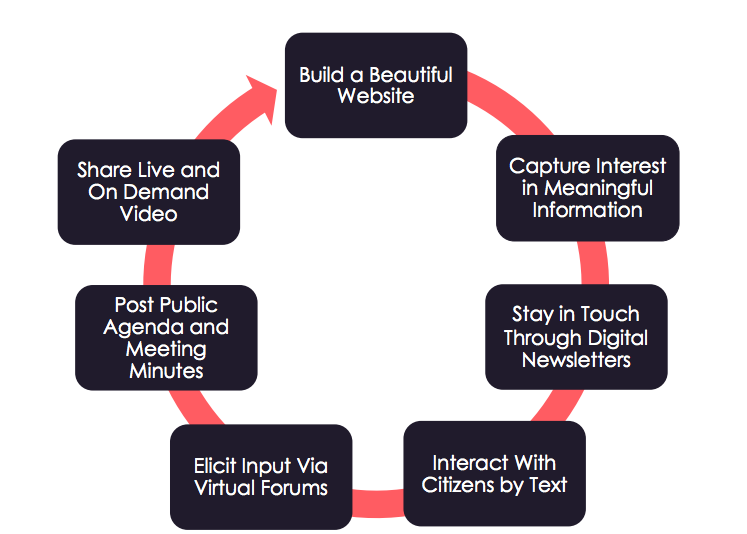
Do you know who powers and maintains the streetlights that guide you safely home at night? What about where the water from your faucet comes from? Which organization is in charge of ensuring that when you flip a switch the lights come on? You might not know it, but many times it’s a special district.
Special districts are a unique form of government organization that provide a wide range of services, including those that tackle some of the most fundamental, day-to-day livability issues. But because many people are unaware of them, special districts need to demonstrate and communicate their value effectively to ensure continued success in the future.
To address that conundrum, Granicus held a webinar, “Special District Spotlight: The Importance of Remaining Visible in the Digital Age,” yesterday to discuss strategies, tools and success stories. Two Granicus experts and Sylvia Romero, Governance and Policy Manager at Pedernales Electric Cooperative—itself a special district—spoke during the webinar. Below are some of the takeaways.
Special districts have a somewhat bifurcated audience. On one side there are constituents or taxpayers/ratepayers that want to know the value of services they’re receiving in exchange for footing the bill. On the other, these districts often must work with mayors and councilmembers, city and county departments, and even other special districts.
It’s further complicated by the media-saturated environment that we live in, where the average person now consumes more than 10.5 hours of content every day. On top of that, content consumption is increasingly mobile—we typically check our phones nearly 50 times per day.
That posed a challenge: How do you cut through the noise and reach all of your audiences…all without blowing up your comms or legislative budget? It involves a process, according to Byron Gillin, a Legislative Management Expert at Granicus.
Gillin walked through five steps to engage constituents in the work of special districts:

The Pedernales Electric Cooperative covers over 8,000 square miles of mostly rural Texas. About a year ago, they discovered Granicus’ tools, which has helped transform how it’s effectively managed over a quarter-million accounts.
The cooperative now uses Granicus’ Legislative Management tools to build an electronic meetings and agendas packet, and both open and executive meetings can be managed completely on iPads. This means executives have a single place to find the information they need and can even vote electronically. Meetings are livestreamed to ensure constituents are able to see the proceedings and watching voting in real-time.
Making Pedernales a more open and transparent organization “has really excited them,” said Sylvia Romero, Governance and Policy Manager at PEC.
While constituents are sometimes locked into certain special district services, that’s not the case for all of them. Places like ports or transit agencies rely on people opting to use their services—and that means making sure people know they exist.
“This isn’t a field of dreams,” said Shawn Pillow, a Solutions Engineer at Granicus. “Just because you built it doesn’t mean they’ll come—you need to let them know about it.”
For instance, the Port of Tacoma relies on freight and shipping companies using them as a way to move goods. But they also must be responsive to taxpayers who help foot the bill.
They had no issues sending out emails, but they struggled to grow their list of subscribers. By using Granicus’ GovDelivery Communications Cloud—and its GovDelivery network, which connects more than 170 million people worldwide—the port was able to grow its network by 268 percent. The people who signed up are clearly interested, as they have a 40 percent engagement rate, well about the average rate for the public sector. By communicating more effectively to a larger audience, they also sparked interest in what the port does – constituent tours have increased dramatically since the switch.
Another agency that is using communication to show its value is Dallas Area Rapid Transit. DART serves Dallas and 12 surrounding cities, providing more than 200,000 rides every day. When a bus route changes or there are system-wide delays, riders need to know so they can plan ahead. Otherwise, frustrated choice rides could opt to drive to where they need to be instead. By using GovDelivery, its 65,000 subscribers receive more than 9 million messages. By ensuring that they’re sending out segment and quality content, they’ve managed to get an engagement rate north of 50 percent.
This came in handy when an updated version of DART’s app—which allowed for mobile ticketing—was rolled out. Initially worried that they would need to do individual outreach to some people to get them to update, DART was able to use GovDelivery to push out a message to everyone who might be affected. That’s time and money saved.
Is your digital strategy up to snuff? Check out our 2017 Benchmark Report: Insights for Mapping an Effective Digital Strategy to find out. If you’re ready to improve how your special district operates, contact us at info@granicus.com.